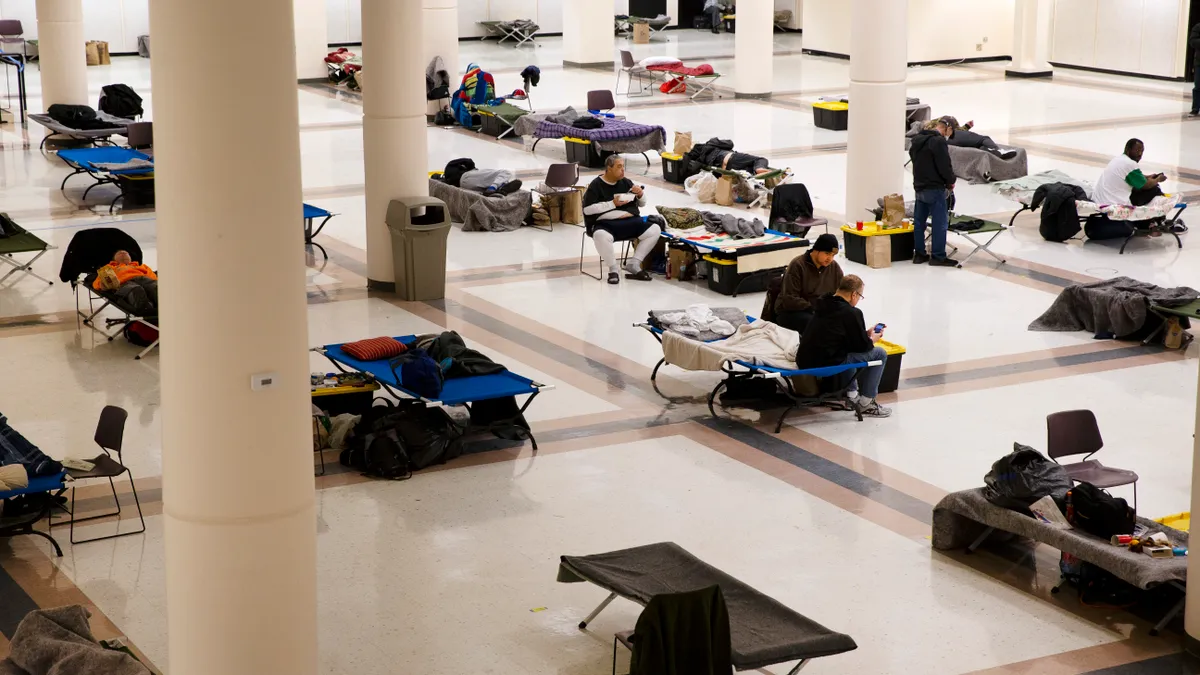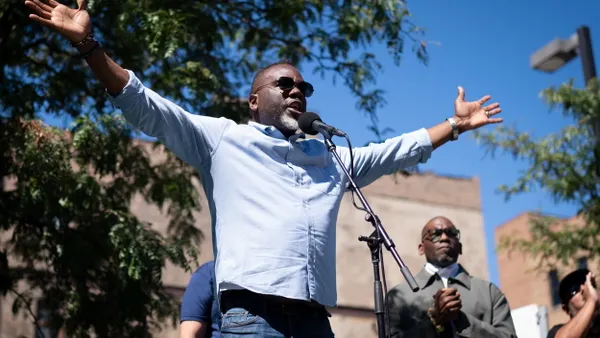Dive Brief:
- An annual report from the U.S. Department of Housing and Urban Development (HUD) found that more than 326,000 people experienced sheltered homelessness on a single night in the U.S. in 2021, down 8% from the previous year.
- The Annual Homeless Assessment Report (AHAR) to Congress, based on data from the point-in-time count conducted in January 2021, reflects the impact of emergency housing assistance during the COVID-19 pandemic. In a statement, HUD Secretary Marcia Fudge said the decrease from 2020 “suggest that federal COVID-19 relief had positive impacts on sheltered homelessness” and said the administration would continue to lean on funds from the COVID relief bills passed by Congress and other resources to work toward the goal of ending homelessness.
- The National Alliance to End Homelessness cautioned that the 2021 AHAR may not give a full picture of homelessness in the U.S., however, because the pandemic prevented data collection from the estimated 40% of the homeless population that is unsheltered on a given night, and some cities did not conduct a count last year. Nan Roman, CEO of the nonprofit, added in a statement that because the findings reflect the impact of emergency assistance, “without continued investment, we anticipate homelessness will rise again in the coming months.”
Dive Insight:
Early in the COVID-19 pandemic, the federal government instituted a suite of emergency measures to keep people in their homes amid economic uncertainty. That included a federal moratorium on evictions, billions in rental assistance and mandated mortgage payment forbearance. Cities also instituted their own housing programs, some of which continued after the federal eviction moratorium expired last year. The improved homelessness numbers from 2021 indicate that those measures likely kept people off the streets, said Samantha Batko, principal research associate at the Urban Institute’s Metropolitan Housing and Communities Policy Center.
“Because there were so many emergency resources directed at families, the decrease in the number of families experiencing sheltered homelessness likely is a result of measures like eviction moratoria and the rental assistance funneled into communities,” she said. “It’s challenging to know just with this count if that is the case for sure. Families could be experiencing homelessness in other situations, or just avoiding shelters because of COVID, but I would expect the moratoria played a role.”
The AHAR data continued to show a year-over-year decline in the number of people experiencing sheltered homelessness that began in 2015, although the 8% drop was steeper than in other years. The number of sheltered homeless families with children fell 15% between 2020 and 2021, which could reflect the impact of the eviction moratoriums and emergency rental assistance programs. The number of sheltered veterans also fell 10%, possibly reflecting emergency assistance targeted at that population. The report also found that the reported inventory for people experiencing homelessness stayed relatively flat, although the number of beds in non-congregate settings rose 134%.
That increase is in part due to city and state initiatives to purchase rooms in hotels and motels to house people experiencing homelessness, offering beds in environments that were seen as safer, said Gary Painter, director of the Sol Price Center for Social Innovation and the Homelessness Policy Research Institute at the University of Southern California. California has worked to extend its Project Roomkey program to offer temporary housing, and other cities, including Kansas City, have adopted similar programs.
“This shows that you can move quickly to house people if you have the resources,” Painter said. “People who would have felt uncomfortable or unsafe in a standard setting were able to be housed in a hotel or motel situation. It was quite positive to show that something like this could be done.”
While the overall numbers were down, the AHAR report found that the number of chronically homeless people in shelters increased 20%, and that population includes "many of the highest-need individuals." The number of sheltered transgender and "gender non-conforming" youth also increased, the report stated.
The emergency measures have provided a model as more governments seek ways to address the affordable housing shortage. A June 2021 report from the Harvard University's Joint Center for Housing Studies warned of a “wave” of foreclosures and evictions without further assistance. Many cities have tried to extend or modify their housing programs — especially by offering more aid and legal and technical assistance to renters — to keep people housed.
While Painter said that it may take until HUD’s next data release — likely in late summer — to understand the full scope of the impact of COVID-19 assistance on housing, the early returns do indicate that the policies could be effective if they are made permanent.
“We know from previous research … that actually making eviction a little more difficult has significant impacts on reducing homelessness,” Painter said. “We had this catastrophic experiment as it relates to housing stability, and so far, it looks like the eviction moratorium did matter in reducing homelessness. It speaks to the idea that maybe the balance of power between renters and landlords and property owners needs to shift if we’re going to reduce the broad social outcomes that we know are harmful.”













